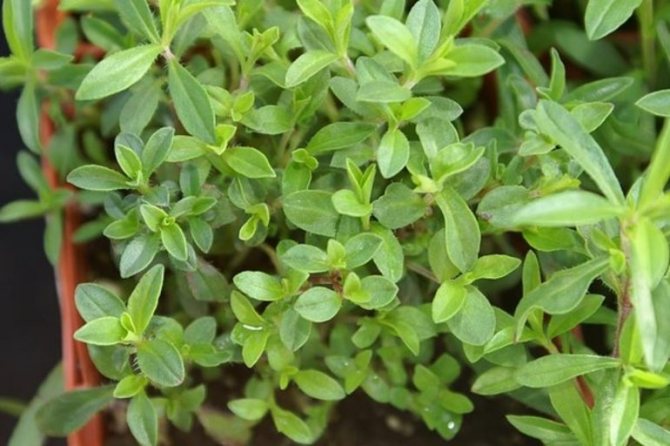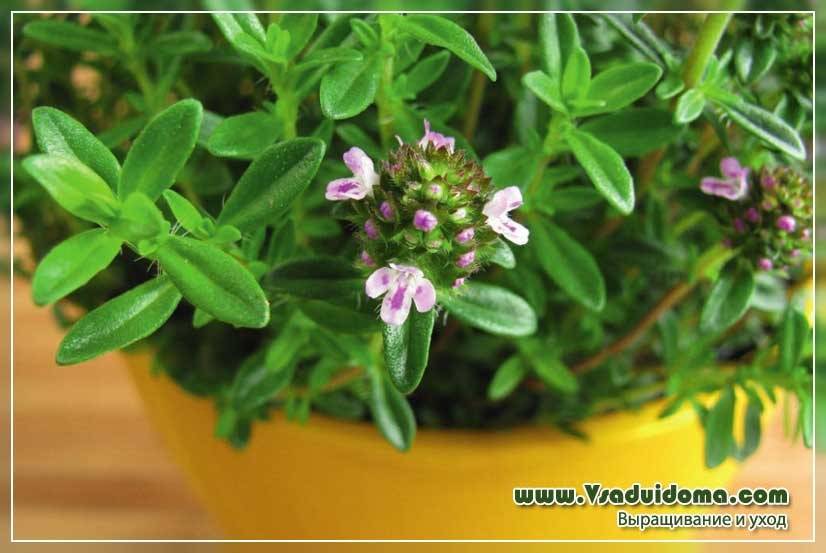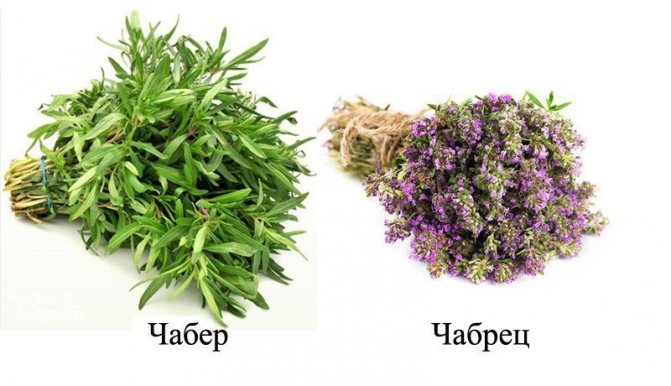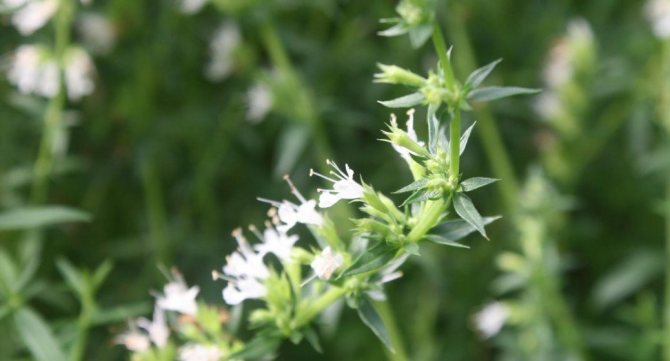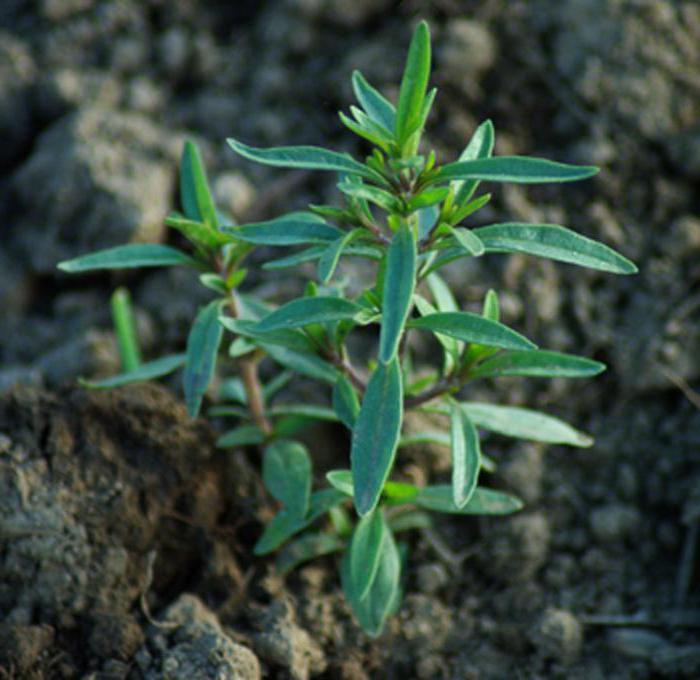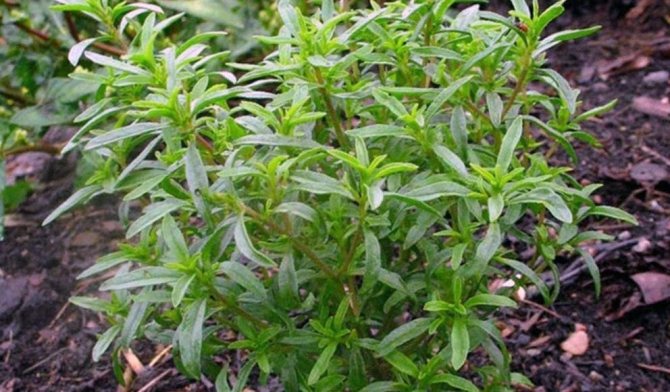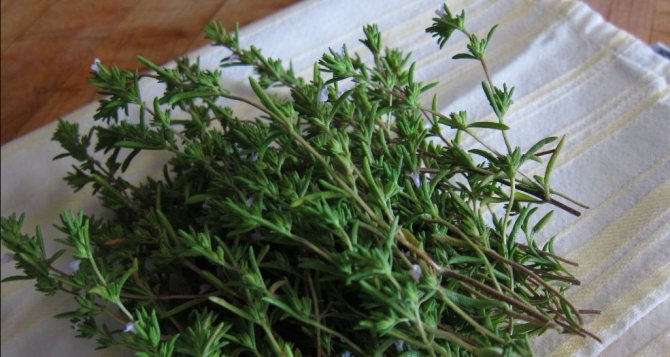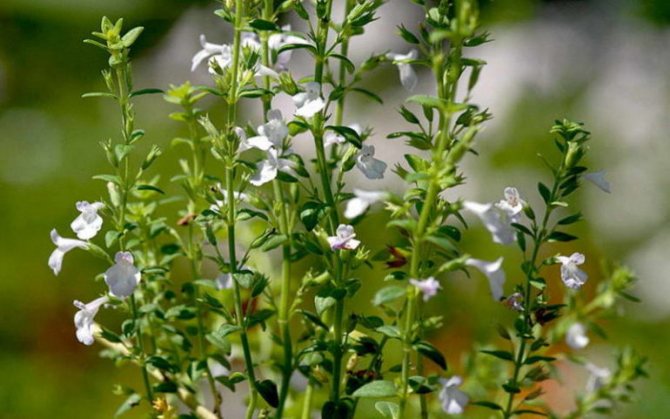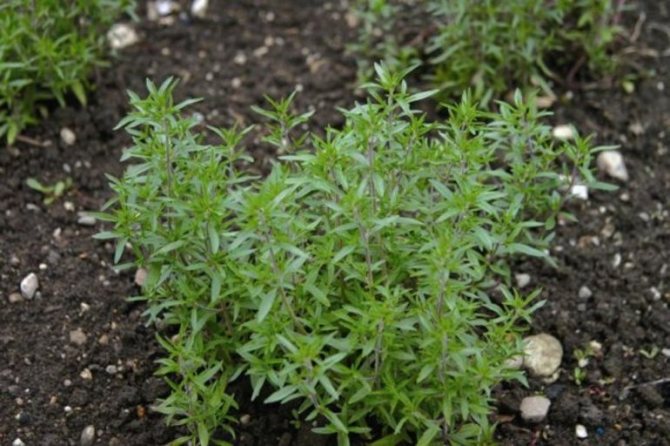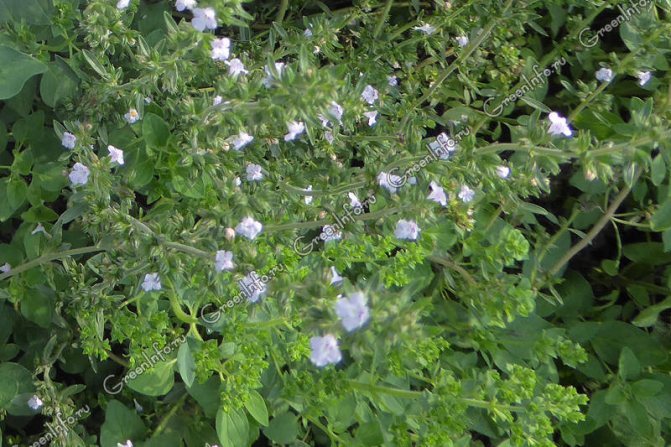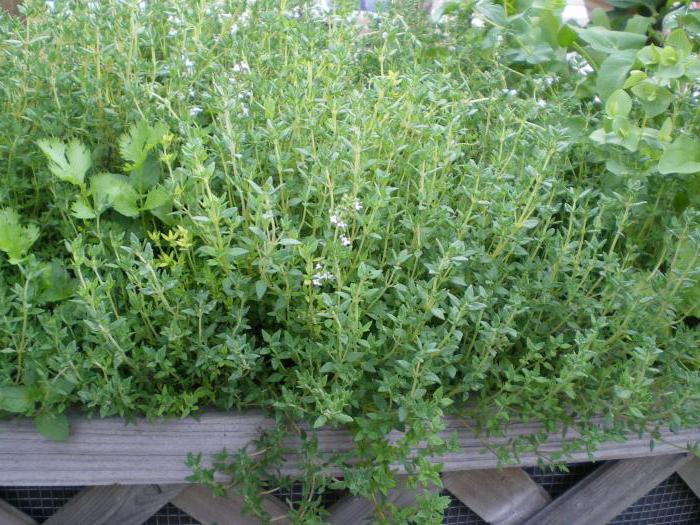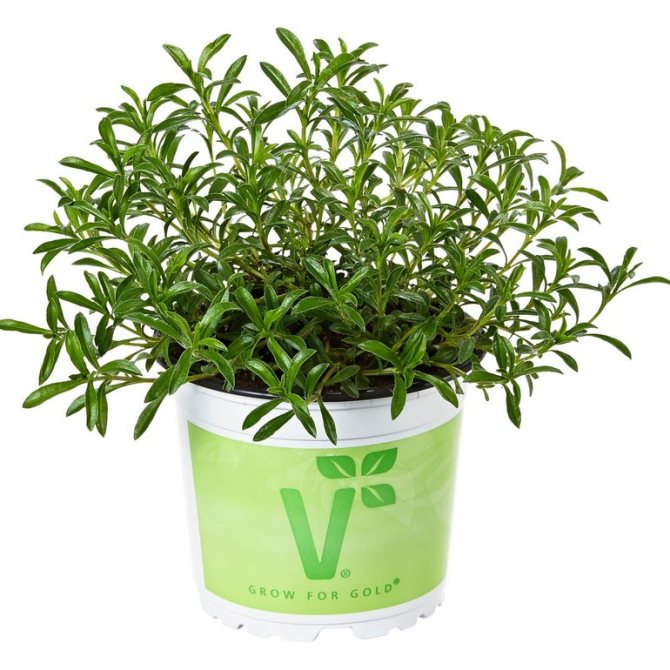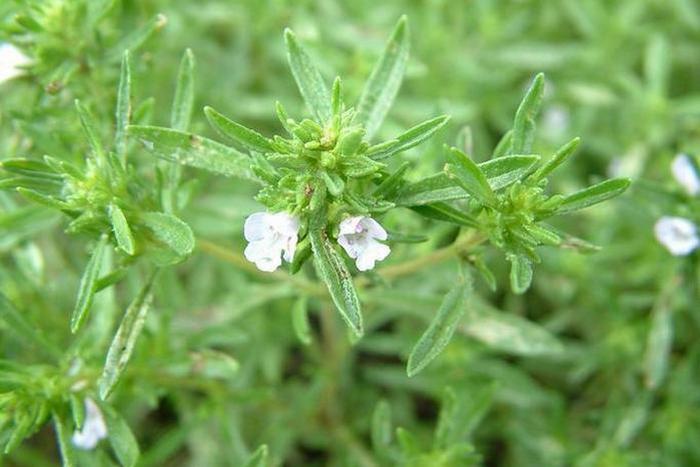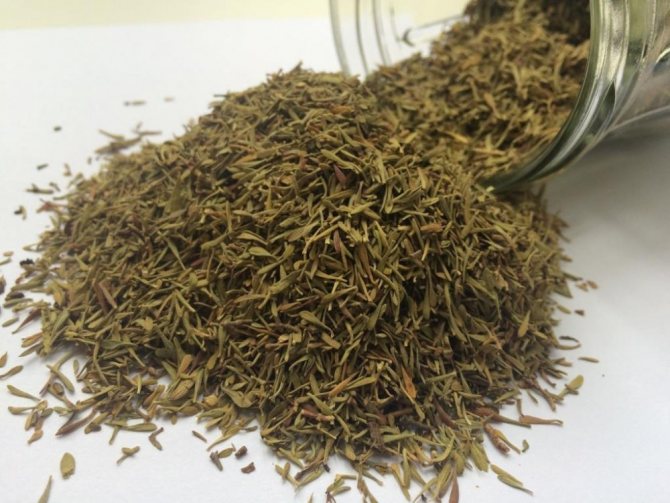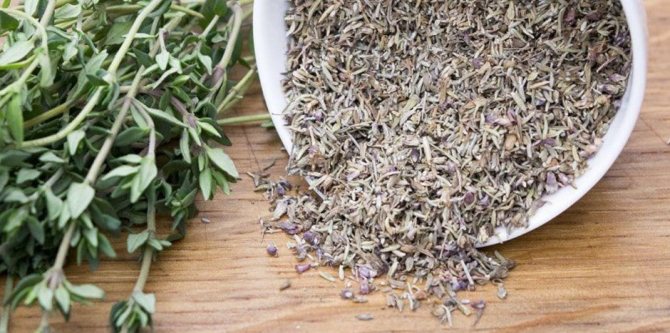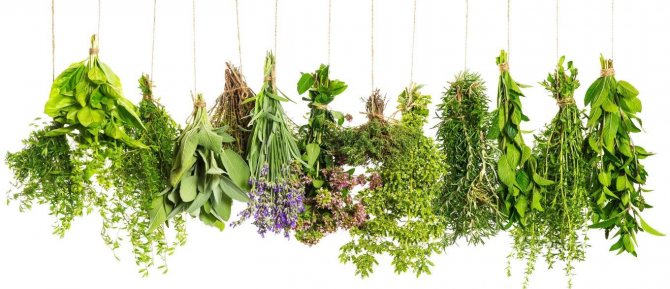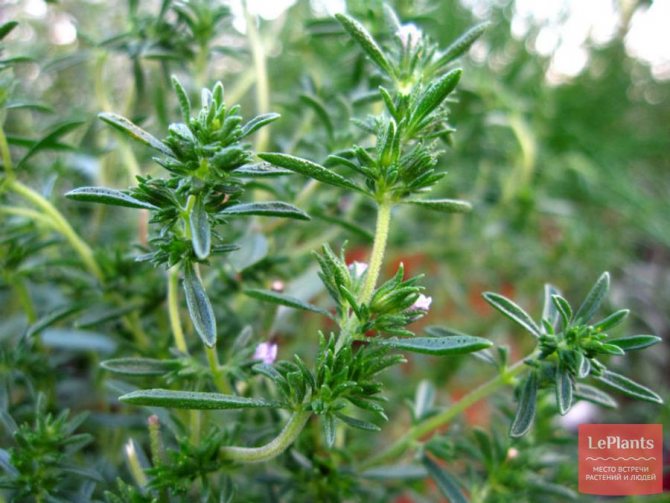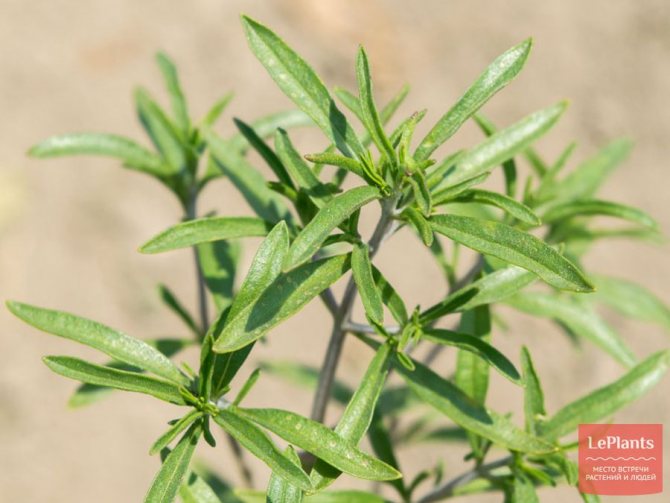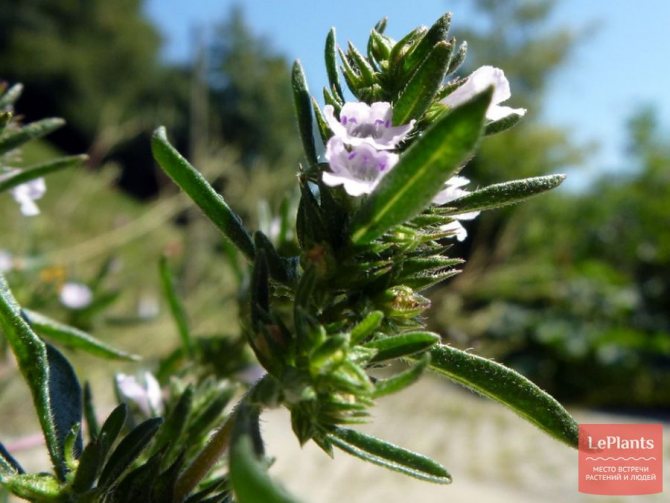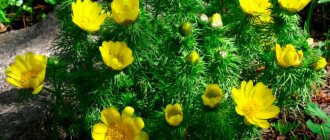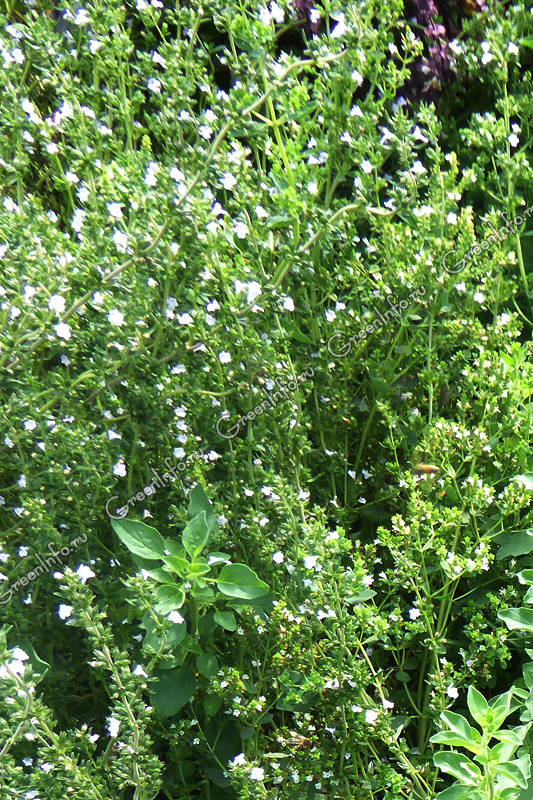
Savory garden Breeze
As a gingerbread plant, savory has been known since ancient times; it is one of the most beloved spicy plants in the Middle East and Transcaucasia, where it is widely used to make the famous adjika and hop-suneli.
In culture, two species are known - garden savory (annual) and mountain (perennial).
The annual savory belongs to the family of the labiate, or lamb. This nondescript-looking plant is loved for its subtle aroma. It is not for nothing that the people call it fragrant savory or pepper grass.
It is a branchy, low-growing plant 25–50 cm high with a lignified stem below. The stem is pigmented, covered with short hairs. Its root system is very poorly developed and is located mainly in the surface layer of the soil.
Leaves are lanceolate, pointed, gray-green, 1.5-2.5 cm long, dotted with pinpoint glands. The flowers are small, white and pink, 2-3 pieces in inflorescences, located in the leaf axils. Long-term flowering and maturation of seeds. Seeds remain viable for 2 years.
The compact globular savory bushes are very decorative, so many gardeners use them as curb plants, planting along the paths. They are also beautiful for growing in a pot culture on a balcony or loggia, and even on a windowsill in winter.
Savory is thermophilic, its seedlings do not tolerate frost at all. He is picky about light and prefers open, bright places, protected from cold northerly winds. It is undemanding to soils, but it grows especially well on light, cultivated and abundantly fertilized soils, especially after vegetable crops, under which organic fertilization has been applied.
And yet they are different ...
First, let's carry out difference between savory and thyme plants... After all, many believe that they are one and the same thing. In fact, these are different cultures, although they belong to the same family of beetles. Savory is an annual, and its relative is a perennial plant. Most often it spreads along the ground, while savory has erect and taller stems. Thyme is called in another way thyme, and we talked about its garden form on the pages of the publication.
Characteristic
Garden or fragrant savory is a herbaceous cross-pollinated plant. The stem is branched, covered with short hairs, with a purple tint. Leaves linear-lanceolate, narrow, pointed, dark green with a solid edge. The flowers are small, light purple or pink, sometimes light yellow, almost white, located in the leaf axils. The seeds are small, black-brown, their germination capacity lasts 3-7 years.
This is an early ripening, relatively cold-resistant plant, it can easily tolerate small frosts. Demanding light, prefers open, sunny places and fertile light soils.
RARE PLANT SEEDS FOR YOUR GARDEN - FREE SHIPPING. PRICES ARE VERY LOW. THERE ARE REVIEWS


The healing properties of the plant
Savory is widely used in medicine and has many beneficial properties. It can rightfully be called a natural antiseptic. It is used for diseases of the stomach, intestines, relieves worms, has a disinfectant effect, relieves pain. Greens are applied to the wounds, after an insect bite, chewed, then applied to the tooth for pain.Good results are obtained by rinsing with a decoction of leaves for tonsillitis, purulent inflammation of the mucous membranes. Various lotions and baths are used for diseases of the joints, for rheumatism. Add a pinch of savory to your tea and you will feel energy filling you. Using the medicinal properties of this plant, you can ease the course of many diseases, get rid of pain. Greens contain an essential oil that has a distinct aroma. They are also added to baths, used for rinsing the throat with sore throat, with diseases of the mucous membranes.
Like many medicinal plants, savory has contraindications. It cannot be used when:
- duodenal ulcer;
- kidney disease, liver disease;
- pregnancy, as there is a chance of miscarriage;
- diseases of the thyroid gland;
- hypertension and atrial fibrillation;
- atherosclerosis
For all of the above diseases, you can use fresh and dried herbs in cooking, as well as make various lotions. In such use, you will not harm your body.
Savory varieties
Savory varieties differ mainly in the shape and height of the bush. There are tall, reaching 50 cm, as well as undersized plants - 25-32 cm. The latter, for example, includes the Gnome variety. An overview of the most popular varieties is given below.
Fragrant... Mid-season variety. The period from full germination to flowering is 45-48 days. The plant is up to 50 cm high, with a well-developed main stem, spreading. The leaf is lanceolate, dark green in color. The leaf edge is smooth with a medium waxy bloom. The flower is light purple. Strong aroma. The mass of one plant is 140 g. Plants are cut during the period of mass flowering.
Filevsky... Mid-season variety. The growing season from full germination to technical ripeness is 60-70 days. The bush is compact, 40-50 cm high. The stem is branched, covered with short hairs, not lodging, lignified at the base. The leaves are green with a strong spicy taste and aroma reminiscent of pepper. The flowers are pink. The mass of one plant is 160-190 g. The aroma is well preserved in dried herbs. The variety is resistant to lodging.
Lobio... The variety is a Caucasian savory population with a strong spicy-peppery taste and aroma. Forms highly branching bushes with a diameter of 8-10 and a height of up to 25 cm.
On a note
Vegetables for which organic fertilizers were applied (cucumber, cabbage) are good precursors for savory.
Chemical composition
Dried savory retains a surprisingly high amount of vitamins and minerals.
Nutritional value of dry savory (Satureja hortensis) per 100 g.
| Name | number | Percentage of the daily value,% |
| Calorie content | 272 Kcal | 13,5 |
| Carbohydrates | 68.73 g | 53 |
| Protein | 6.73 g | 12 |
| Fats | 5.91 g | 30 |
| Dietary fiber | 45,7 g | 120 |
| Niacin | 4,080 mg | 25,5 |
| Pyridoxine | 1,810 mg | 139 |
| Riboflavin | 0.471 mg | 36 |
| Thiamine | 0.366 mg | 30,5 |
| Vitamin A | 5310 IU | 177 |
| Vitamin C | 50 mg | 83 |
| Sodium | 24 mg | 1,5 |
| Potassium | 1051 mg | 22 |
| Calcium | 2132 mg | 210 |
| Copper | 0.877 mg | 94 |
| Iron | 37.88 mg | 474 |
| Magnesium | 377 mg | 94 |
| Manganese | 6,100 mg | 265 |
| Phosphorus | 140 mg | 20 |
| Selenium | 4.6 mcg | 8 |
| Zinc | 4.30 mg | 39 |
Sowing savory
Grass is usually grown in open ground, sowing seeds immediately to a permanent place. The plot is prepared two weeks before sowing. For 1 mg add 3-4 kg of manure, 15-20 g of potassium chloride and 10-12 g of ammonium nitrate. The soil is dug up, leveled.
Sowing a plant in the ground is best in early spring. Sowing is carried out at the end of April - May. In order to have fresh greens throughout the summer-autumn period, savory can be sown at several times with an interval of 10-15 days.
Before sowing, the seeds should be soaked for a day in a damp cloth, then dried to a state of flowability, and then sowing should be started - with row spacing of 30-40 cm and a depth of seeding of 0.5-1 cm. For better germination, savory crops can be covered with spunbond.Simultaneously with sowing, ammophos or superphosphate is introduced into the rows (1 tsp per 1 running meter). At normal humidity and temperature, seedlings appear in 10-15 days.
Advice
In the middle lane, you can carry out subwinter sowing in November. Seed consumption per 1 m2 is 0.3-0.5 g. Before winter, the crops are sprinkled with peat or humus. With podzimny sowing, ripening occurs about 3-4 weeks earlier.
Seedlings
Savory is also grown as seedlings, especially for the purpose of obtaining seeds or on heavy, floating soils where it is difficult to get good shoots. To do this, at the beginning - mid-April, sowing is carried out in a greenhouse (in sowing boxes) or a greenhouse, seedlings are thinned out, and in mid-May the plants are planted in the ground. It is better to sow directly into peat-baked or plastic pots 5 × 5 cm, since savory, like many other taproot plants, does not like transplants. But you can also dive it.
When two or three true leaves appear, the first thinning is carried out, leaving a distance of 7-10 cm between the plants, and in the phase of 4-5 leaves - the second with an interval of 15-20 cm.
Growing at home
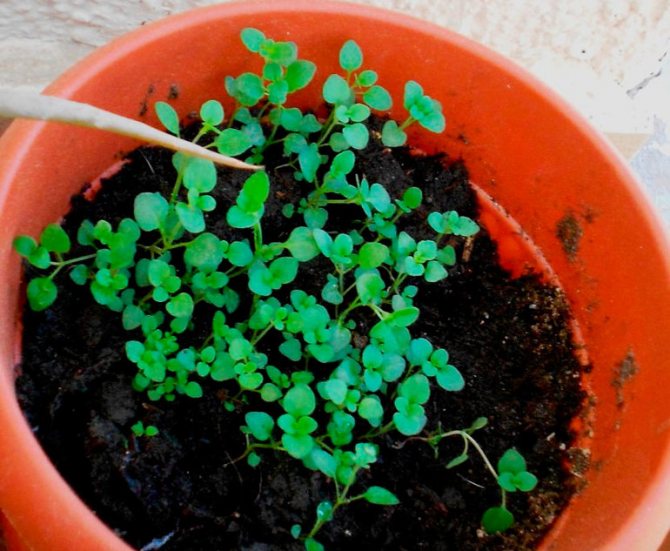

It will not be difficult at all to grow savory right on the windowsill. For this, undersized varieties are selected, with small bushes, for example, Semko, Filevsky, Breeze, Charlie. They are planted in pots in late autumn. Before planting, the rhizomes are divided into segments. Such plants will give a wonderful strong aroma throughout the winter.
To plant savory in March, you need small boxes or pots. Already in the soil, the seeds are additionally compacted. As they grow, the bushes need to be thinned out, keeping a distance of 5 cm between them. A month later, they are transplanted into pots directly with the rhizome.
Savory care
In the future, caring for the garden savory consists in weeding the beds from weeds, watering, loosening the soil. Watering should be moderate. During the growing season, one top dressing is carried out with a solution of urea (10 g per 10 l of water).
Cleaning and storage
Mass harvesting of savory is carried out during the beginning of flowering. The stems are usually cut at the base.
During the season, you can selectively cut the stems at a height of 10 cm or at the branching points, which stimulates the regrowth of young shoots.
For harvesting for future use, the stems are dried under a canopy or in a well-ventilated area. Drying temperature should not exceed 35 degrees. With 1 mg, 300-400 g of dry weight are obtained. Dried savory retains the aroma perfectly and even enhances it.
Dried plants are stored in glass jars, tightly closed with polyethylene lids. Dried savory leaves retain their aroma for two years.
Another approach is to harvest savory seeds. They crumble when ripe, so you should not linger with harvesting. In late August - early September, when the seeds acquire a dark brown, almost black color, all plants are pulled out by the roots or cut off from the ground and hung in the attic for drying. You need to spread something under the plants or put paper bags on them in order to collect the crumbling seeds later. After drying, the plants are threshed.
Biological description and distribution
Savory is an annual shrub or semi-shrub from the Lamiaceae family. It grows mainly in Asia and the Mediterranean. Gardeners cultivate it on their plots. Harvested exclusively at the beginning of flowering.
The plant has a branched and erect stem with an average height of 50 centimeters. The flowering period is July-August. The buds are white, purple or light purple in color with purple spots. By the beginning of autumn, the inflorescences form fruits of a pale brown color, resembling nuts in appearance.
Savory is also called "pepper grass". His homeland is the Mediterranean coast. The plant was known in ancient times.The Romans made it into a sauce for dressing fish and meat dishes, and Europeans added it to meat rolls, fish sauces, sausage and pork pies.
In the 9th century, the pepper herb was introduced by monks to Central Europe. Its low cost has made it a very popular condiment.
Savory in cooking and folk medicine
Savory is widely used in cooking. Fresh or dried herb is an excellent spice herb. It goes well with fresh cucumbers in salads, suitable for dishes from young potatoes, fish, poultry. Can be used as a breading.
As a spice, this plant is added to dishes from meat, poultry, vegetables, mushrooms, cold snacks, soups, sauces. Savory is used for pickling, canning and salting. For 1 liter of marinade or brine, 0.5-1 g of dried savory goes.
Garden savory is known in folk medicine as a medicine that helps with gastrointestinal diseases, as a sedative and pain reliever. It is recommended by traditional healers for diseases of the kidneys, liver, gallbladder, as well as diabetes. In addition, savory preparations have an antihelminthic and diaphoretic effect.
Recipe
Savory decoction is used as an expectorant for coughs caused by ARVI, influenza, bronchitis, pneumonia. 1 tbsp. l. dry herbs pour 300 ml of boiled water to insist for 20 minutes, strain and drink every 10 minutes in small sips. All liquid should be drunk during the day.
Health Benefits of Savory
The fragrant leaves and delicate shoots of savory contain incredibly high-quality chemical compounds - antioxidants that prevent disease and promote health. Plus, the fiber in this herb helps lower LDL (bad) cholesterol while raising good cholesterol.
Savory leaves contain many important phenolic esters such as thymol and carvacrol, as well as compounds such as linalool, camphene, caryophylline, terpineol, myrcene, and other terpenoids.
It is known that thymol, one of the important essential oils, has antiseptic, antifungal properties.
In addition, another phenolic compound, carvacrol, inhibits the growth of many strains of bacteria and is used as a food additive and preservative due to its antibacterial properties. It also gives the savory a pleasant, tangy flavor.
Savory is an excellent source of minerals and vitamins that are essential for maintaining health. Its leaves and shoots are rich in potassium, iron, calcium, magnesium, manganese, zinc and selenium. Potassium is an important component of cells and body fluids that help control heart rate and blood pressure. The human body uses manganese as a cofactor for the antioxidant enzyme, superoxide dismutase. Iron is required for the formation of red blood cells.
This spicy herb contains many important vitamins such as B vitamins, vitamins A, C, niacin, thiamine and pyridoxine.
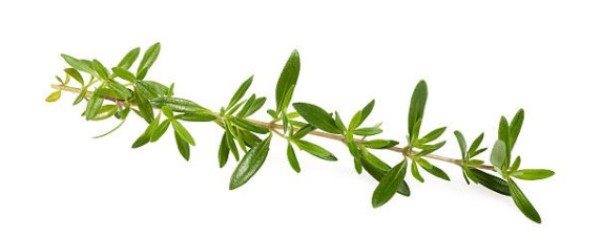

The dried leaves contain 1,810 mg of vitamin B-6 or pyridoxine, which is about 130% of the RDA. Pyridoxine maintains levels of GABA (a calming neurotransmitter) in the brain.
Vitamin C helps the body develop resistance to infections and scavenge harmful free radicals.
Vitamin A is a fat-soluble vitamin and antioxidant that is essential for maintaining healthy mucous membranes and skin, as well as good vision. Consuming natural fruits rich in flavonoids such as vitamin A (carotene) helps protect against lung and oral cavity cancers.
Savory contains many valuable essential oils that have antibacterial and antifungal properties.
Like thyme, savory tea is used as a gargle to relieve symptoms of sore throat and bronchitis.
This spice increases the secretion of gastric juices, which can help relieve a variety of digestive disorders, including bloating and flatulence.
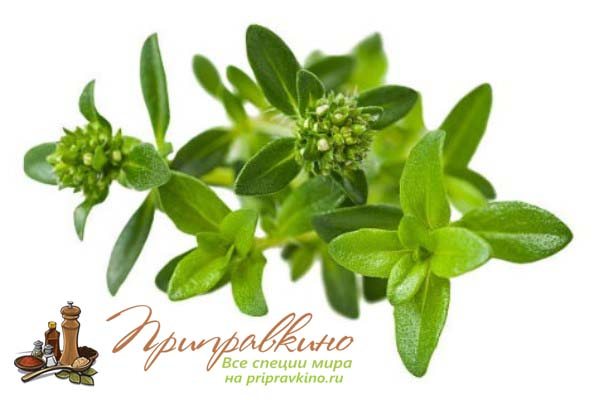

CULTIVATION OF CHABER, ITS PROPERTIES AND APPLICATION - TIPS AND FEEDBACK
CHABER AND THYME ARE NOT THE SAME!
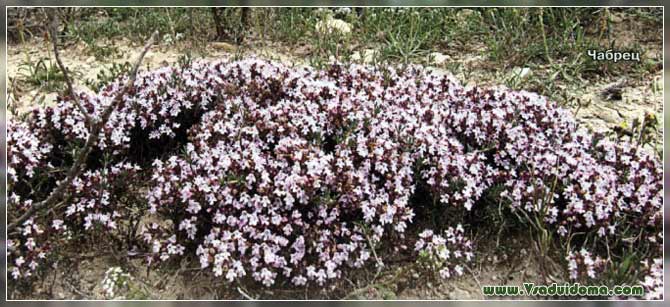

Because of the similarity of the names, savory and thyme are often confused.
Although they have in common only that they belong to the same family of labiates and come from the Mediterranean countries.
Savory (Satureja hortensis L.) comes from the eastern regions of the Mediterranean. As a weed plant, it often grows in the south of the European part of Russia, in the lower reaches of the Volga and Don, in the Black Sea region, in the Crimea, in the Caucasus, in mountainous Turkmenistan and in the Tien Shan, preferring arid, sunny, rocky places.
Savory is an annual aromatic herb 15-40 cm high with a bitter-burning spicy taste. It is very thermophilic, withstands a short-term cold snap, but dies even with minor frosts.
Savory is grown by sowing seeds before winter or in early spring directly into the ground or by seedlings (sown in greenhouses in April). At temperatures above 14 °, seedlings appear in 8-10 days. The optimum temperature for plant growth and development is 20-25 °.
Savory works best in sunny places, on calcareous loose loamy and sandy loamy soils rich in humus. But on soils heavy, damp and cold, as well as on salted savory, it is better not to plant savory - here it will feel oppressed.
Savory leaves are used in food raw, dried or boiled as a seasoning for salads, soups, meat, vegetable dishes, when cooking sausages, as a spice when pickling cucumbers and tomatoes. They are especially good with tender meat - chicken, veal, turkey (say, as an aromatic addition to sauces) and beans. They are also added to tea (for which leaves are collected just before the flowering of plants).
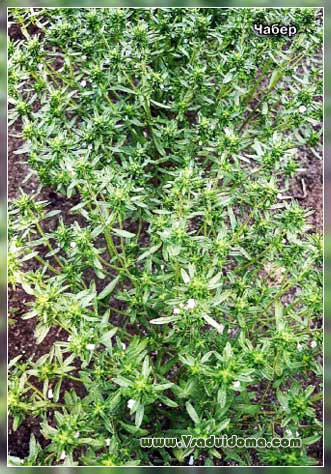

In the garden, savory is well compatible with onions and beans. The scent of the plant's flowers attracts hymenoptera and predatory insects. Therefore, savory is the best crop for attracting, uniform and constant accumulation of entomophages in vegetable gardens.
Thyme is a completely different plant belonging to the genus Thymus L. The genus includes about 400 species of perennial evergreen or semi-evergreen shrubs or semi-shrubs.
The flowering of thyme in the garden is accompanied by a strong pleasant honey aroma. The plant is an excellent melliferous plant (honey productivity is 40 kg per hectare, with continuous thickets, bees produce 160-181 kg of honey per hectare). Flowers release nectar even in dry years. Thyme grows in a thick carpet, and the bees do not fly from flower to flower, but move from one flower to another. And as a result, they collect so much nectar in the goiter that they cannot take off with a heavy load and are forced to spend the night on flowers.
Thyme is used in medicine as a disinfectant, anesthetic and antiseptic, and in the perfumery and food industries - as a spice and essential oil plant. Some flowering species are promising for use in landscaping.
ORDER QUALITY AND CHEAP SEEDS AND OTHER PRODUCTS FOR HOME AND COTTAGE. PRICES ARE BOTTLE. CHECKED! JUST LOOK FOR YOURSELF AND BE AMAZED HOW WE HAVE REVIEWS. GO >>>
Below are other entries on the topic "Cottage and garden - do it yourself"
- Schlumberger - photo, care and reproduction: Schlumbergera - growing and ...
- Drooping reed - care, photo and reproduction: Drooping reed (Scirpus Cernuus) Herb ...
- Herbs with lemon scent - photos and names: What herbs smell like lemon Among spicy ...
- Cassiopeia (plant) - photo, planting and care: Cultivation of Cassiopeia - planting and ...
- Irezine home care: irezine plant - planting and ...
- Agapanthus flower - tips for growing and care. Photos and several beautiful varieties .: Agapanthus plant: varieties and care ...
- Odontations - home care: Cultivation of odontations and care for ...
Subscribe to updates in our groups and share.
Culinary Tips
Put a pinch of savory or other spices in vegetable oil, leave for a few days. Now add aromatic oil to salads and other dishes, they will sparkle with a new note.
Add fresh leaves to various salads and appetizers, add dried to the first courses 5 minutes before the end of cooking. In the event that you will be frying food, add it before cooking.
Fresh and dried herbs contain many useful components, essential oils, phenolic compounds. Tea made with the addition of fresh and dried plants will help:
- relieve fatigue;
- improve the functioning of the digestive system;
- normalizes blood pressure;
- relieve spasm and pain
To prepare a fragrant drink, take a pinch of dried herbs or a few fresh twigs, add water, and let it boil. Let it brew, drink with pleasure, adding honey or sugar as desired.You can simply add a little spice to black tea for a fragrant tonic drink. If you add fresh leaves, you need to add a little more to add richness and aroma to the drink. Your delicious, aromatic drink is ready. Drink and be healthy!
More fresh and relevant health information on our Telegram channel. Subscribe: https://t.me/
Growing conditions
Savory prefers to grow in dry, warm places in full sun. The soil can vary, but must be well drained as wet soil will cause root problems. In colder areas, it tolerates temperatures as low as -6 C, but will grow as an annual plant. In such regions, it will bloom in the fall, not in the spring. To grow a plant from seeds, they need to be sown in the soil, covered with something and watered sparingly. Alternatively, it propagates from 5-8 cm shoots cut off from the plant in summer.
Plant diseases and pests
Although savory is resistant to diseases and pests, it can be affected by:
- Rot. This disease occurs due to excessive watering of the plant and can lead to the death of the savory. In order to prevent decay of the root system, it is necessary to follow the rules of watering.
- Powdery mildew. This disease manifests itself when the leaves of the plant are affected by the fungus. The spores of the fungus accumulate, which leads to rotting and subsequent death of the plant. It is possible to prevent the development of the disease at the first stages by spraying it with a special antifungal drug, for example, Actellik is suitable for this purpose.
Origins and legends
The plant comes from the Mediterranean and Black Sea regions, thanks to the monks chabe6r came to other continents. It is cultivated everywhere: in Europe, Central Asia, the USA, Africa, Australia.
The ancient Romans endowed savory with miraculous properties: it was believed that wearing a wreath of plant twigs helps to improve memory, clarifies the mind. Only representatives of the highest nobility could afford such a luxury (over time, the savory wreath became a symbol of belonging to the elite).
In Russia, milk pots were fumigated with savory - this way the milk did not sour longer.
The plant is unpretentious in planting and care, savory is grown in the open field and on the windowsill. A harvest of one year, taking into account the possibility of a long shelf life, is enough for several years. The fragrant herb will perfectly fit into the landscape design of the garden, delighting with beauty, at the same time being a source of fresh spicy greenery.
Varieties
In the Lamiaceae family, there are types of savory that are used in medicine and cooking:
All types of pepper grass will thrive and thrive in rocky mountain soil. Loam, sandy loam, loose, well-drained soil will also please this decorative spice.On fertile soils with a neutral pH, garden savory will not only grow a large shrub of green mass, but will also enhance its taste.
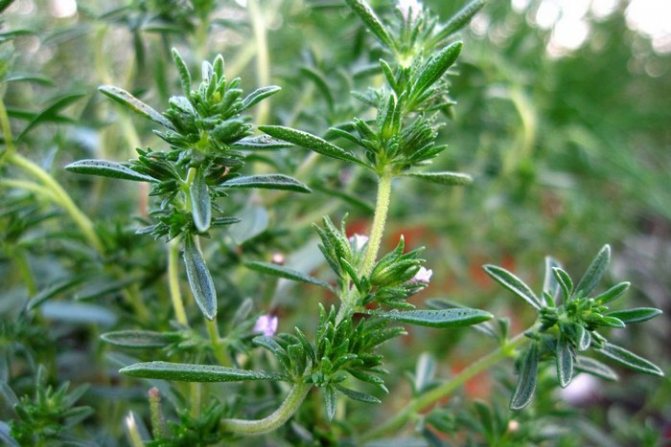

Savory is not suitable for planting in the shade of garden trees and bushes.
The landing site must be chosen open and well-lit by the sun. Savory is not suitable for planting in the shade of garden trees and bushes. It will also be badly affected by the roots of weeds that can capture a large space under the ground. Before planting savory in the garden, the planting site must be prepared by digging it up in advance and removing all weeds. Savory is used not only as a flavoring herb, but also its decorative sides are widely used in landscape design.
How to choose and store?
When choosing a fresh plant, you need to pay attention to the color (it should be rich green) and the appearance of the leaves. Sluggish leaves and twigs indicate that the greens were cut a long time ago, which means they will taste bitter in the dish.
Dried spices are sold packaged. When choosing, you should evaluate the integrity of the package, and also see if there is any excess husk and debris inside.
To preserve savory and all its useful properties, you need to remember the following rules:
- Fresh savory is best kept in the refrigerator, wrapped in a plastic bag. So he can keep freshness for a week.
- To freeze greens, they need to be crushed and immersed in ice cube trays filled with a little water. Greens frozen in this way can be used within 12 months.
- Dry savory can be stored in its original packaging or poured into a separate glass container. Choose a dark, well-ventilated place for storage. A kitchen cabinet or pantry works well. Dried savory retains its taste for about 6 months.
History and geography of habitation
Savory is native to the countries of the East and the Mediterranean... The first records of the plant are in writings from ancient Rome, where pepper grass was used to improve memory and attention. Savory was originally distributed among the representatives of the Italian nobility.
In the eighteenth century, the seeds of the plant first came to Europe, from where they quickly spread throughout all countries due to their high survival rate and rapid growth. Currently, the predominant growth of savory is noted in Southern Europe, Turkey, Crimea, Central Asia.
What is known about the spice savory
Dried savory is a part of ready-made spice mixtures. Among them are Provencal herbs, Khmeli-suneli, Sharena salt. They are added to meat, fish, soups, dressings, sauces, breading. The spice should be used in moderation and added at the very end of the process so that the bitter taste does not overwhelm the rest of the flavors of the dish. Savory is known by different names in different countries. In Bulgaria - chubritsa, in Moldova - chimbru, in the Caucasus - citron, in Uzbekistan - dzhambul, in Georgia - kondari. It is added when preparing a wide variety of dishes; tea is brewed with this herb. A fragrant seasoning can enrich the taste and aroma of any vegetable oil. For this, several green or dry twigs are placed in a container with oil.
Views
Gardeners know several varieties of savory, which differ in appearance and taste of the leaves.
- Savory garden (garden). The most popular type of plant, which is a short, up to 40 cm shrub with small reddish flowers. It has a sweet, spicy aroma that slightly resembles the aroma of oregano and thyme.
- Savory mountain. Creeping dwarf shrub, has small green leaves and white flowers.
- Savory African (lemon). Perennial culture with creeping shoots, small narrow leaves and pinkish flowers, has a pronounced lemon aroma.
- Savory Cretan.A perennial plant with a straight stem and small, light-colored flowers, gathered in inflorescences. The aroma of the Cretan savory is rather mild, a bit reminiscent of the smell of thyme.
- Jamaican savory. It features a straight stem with a large number of dense green leaves, which, when rubbed, exude a mint aroma.
For reference! Savory can be grown not only in the garden, but also at home - it is unpretentious and perfect even for inexperienced gardeners.
Application in cosmetology
In cosmetology, essential oil or savory infusion is used. They have a wide range of effects on the face and hair.
For facial skin
For the skin of the face, savory is useful for its antiseptic properties. It is able to shrink pores and normalize the sebaceous glands, therefore it is used in the treatment of acne. Savory infusions eliminate rashes, heal wounds, relieve redness. To prepare such an infusion, you need to pour 1-2 tablespoons of the plant with a glass of hot water and let it brew for an hour. With the resulting composition, you need to wipe the previously cleansed skin of the face several times a day.
You can prepare an infusion from a collection of herbs: savory, yarrow, rosemary, chamomile, wild mint, St. John's wort and coltsfoot. For cooking, take a teaspoon of the leaves of each herb, mix until smooth and pour a glass of boiling water for 20-30 minutes, and then use it to wipe the skin. Regular use of the infusion tones the skin and saturates it with useful microelements, eliminates redness and rashes.
For hair
Savory infusion is also used for hair care. It is able to strengthen the hair follicles, nourish them along the entire length, giving silkiness and natural shine.
The essential oil will help fight alopecia areata. To do this, it must be rubbed into the hair roots 2-3 times a week for 20-30 minutes.
Indications and contraindications
Indications:
- Erosive gastritis.
- Peptic ulcer disease.
- Arthritis, chronic pain in the joints and spine.
- Low body weight.
- Acute respiratory diseases.
- Intestinal motility disorders.
- Angina.
Contraindications:
- Pregnancy.
- Breastfeeding period.
- Hormonal Disorders.
- Children under 3 years old.
- Individual intolerance.
- Fever.
- Kidney disease in the acute stage.
Reproduction
Since the garden savory is an annual, most often its reproduction occurs by self-seeding. Once having planted it in the garden, you can use its numerous offspring for many years.
However, there are so many varieties of savory, and their flavors are so rich that it is possible to grow several varieties of savory in the garden. For sowing in open ground, it is best to choose late spring, when the sun's rays have sufficiently fried the topsoil.


Garden savory is best planted in late spring.
Also, to collect an earlier harvest, pepper grass seeds are sown in containers in closed greenhouses, then the grown plants are planted in open ground.
Important! The main thing is to protect young seedlings from frost, since savory does not tolerate low temperatures or sudden temperature changes.
Many herbal lovers grow savory in flower pots or windowsill containers. For growing in indoor conditions, the sowing period does not matter much, the main thing is to provide the plant with sufficient light, heat and moisture.
Shallow grooves (1 cm) are made on the bed for sowing garden savory. After sowing, the seeds are covered with soil on top, which is carefully tamped. For additional nutrition, you can pour a small layer of humus or manure on top.
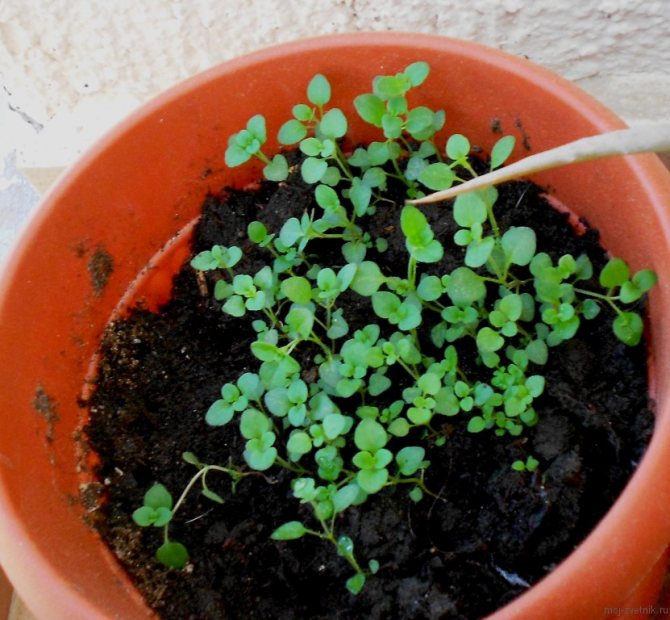

Garden savory planting
To get healthy bushes of savory, you need to take care that beans or cereals were previously grown on the site of its planting, which will enrich the soil and drown out weeds.
Since the plant requires a large amount of fertile land for development, it is impossible to plant savory close to each other.The row spacing should be at least 15 cm; before planting, the soil must be fertilized with rotted manure or complex fertilizers.
For the fastest germination of seeds, they are soaked in warm water a day before sowing.
What to replace in the recipe?
You can replace savory in a recipe with several other spices:
- Sage tastes very much like savory. Its taste gives off pungent notes, but dry spice is not suitable for replacement. Better to take fresh sage and cut into small pieces.
- Thyme has the same pungent flavor with a slight minty undertone. In the finished dish, the difference between the two spices is hardly noticeable. You can replace savory with either fresh or dry thyme.
We care properly
Soil moisture should be moderate. You do not need to fill the planting, but you also should not wait for the soil to dry out strongly. A few waterings per week will be enough. If there is a lot of rainfall, then watering can be skipped.
Check the beds periodically. Try to loosen the soil in time, deepening no more than a few centimeters. Avoid weeds that take nutrients from the soil. And oxygen is needed for the root system.
Before planting, feed the soil with a urea solution at the rate of 10 - 20 grams per 1 m2. Nitrogen will help the aerial part of the shrub grow more strongly and actively.
After harvesting, in the autumn, feed the soil with complex mineral fertilizers. Suitable nitroammofoska - 15 - 20 grams per bucket of water at room temperature, the amount per 1 m2.


